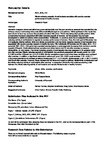The oral nitrate-reducing capacity correlates with peak power output and peak oxygen uptake in healthy humans.
| dc.contributor.author | Thomas, B | |
| dc.contributor.author | Smallwood, S | |
| dc.contributor.author | Cutler, C | |
| dc.contributor.author | Bescos, R | |
| dc.date.accessioned | 2019-03-28T23:04:41Z | |
| dc.date.issued | 2019-06-01 | |
| dc.identifier.issn | 1089-8603 | |
| dc.identifier.issn | 1089-8611 | |
| dc.identifier.uri | http://hdl.handle.net/10026.1/13578 | |
| dc.description.abstract |
Interest in inorganic nitrate and nitrite has grown substantially over the past decade as research has revealed the role of these anions in enhancing nitric oxide (NO) availability through an oral pathway. Nitrite synthesis in the mouth seems to be an important mechanism to feed the circulatory system with this anion. This is interesting since greater plasma nitrite concentration has been associated with better fitness levels in humans, but this question has not been investigated in relation to salivary nitrite concentration. Additionally, no previous study has investigated the oral nitrate-reducing capacity in regards to peak oxygen uptake (VO2peak) or peak power output (Wpeak) in humans. Thus, the main goal of this study was to investigate whether salivary nitrite and nitrate concentration and the oral nitrate-reducing capacity were associated with VO2peak and Wpeak in healthy humans. Fifty individuals (22 females and 28 males; 38.8 ± 14.3 years/old; BMI = 22.8 ± 3.9) performed a graded exercise test on a cycle ergometer to assess their VO2peak and Wpeak. Unstimulated salivary samples were taken before and 20 min after exercise to measure nitrate/nitrite, pH and lactate. The oral nitrate-reducing capacity was also assessed in 25 subjects before and after exercise. Oral nitrate-reducing capacity was positively associated with Wpeak (rs = 0.64; P = 0.001) and the VO2peak (rs = 0.54; P = 0.005). Similar correlations were found when these variables were analysed after exercise. In addition, a significant decrease in salivary pH (pre: 7.28 ± 0.361; post-exercise: 7.16 ± 0.33; P = 0.003) accompanied by an increase of salivary lactate (pre: 0.17 ± 0.14 mmol/L; post-exercise: 0.48 ± 0.38; P < 0.001) was found after exercise. However, these changes did not have any impact on salivary nitrate/nitrite concentration and the oral nitrate-reducing capacity after exercise. In conclusion, this is the first evidence showing a link between the oral nitrate-reducing capacity and markers of aerobic fitness levels in healthy humans. | |
| dc.format.extent | 43-51 | |
| dc.format.medium | Print-Electronic | |
| dc.language | en | |
| dc.language.iso | en | |
| dc.publisher | Elsevier | |
| dc.subject | Exercise | |
| dc.subject | Nitrate | |
| dc.subject | Nitrite | |
| dc.subject | Oral bacteria | |
| dc.title | The oral nitrate-reducing capacity correlates with peak power output and peak oxygen uptake in healthy humans. | |
| dc.type | journal-article | |
| dc.type | Article | |
| plymouth.author-url | https://www.ncbi.nlm.nih.gov/pubmed/30853629 | |
| plymouth.volume | 87 | |
| plymouth.publication-status | Published | |
| plymouth.journal | Nitric Oxide: Biology and Chemistry | |
| dc.identifier.doi | 10.1016/j.niox.2019.03.001 | |
| plymouth.organisational-group | /Plymouth | |
| plymouth.organisational-group | /Plymouth/Faculty of Health | |
| plymouth.organisational-group | /Plymouth/Faculty of Health/School of Health Professions | |
| plymouth.organisational-group | /Plymouth/REF 2021 Researchers by UoA | |
| plymouth.organisational-group | /Plymouth/REF 2021 Researchers by UoA/UoA03 Allied Health Professions, Dentistry, Nursing and Pharmacy | |
| plymouth.organisational-group | /Plymouth/Research Groups | |
| plymouth.organisational-group | /Plymouth/Research Groups/Institute of Health and Community | |
| plymouth.organisational-group | /Plymouth/Research Groups/Plymouth Institute of Health and Care Research (PIHR) | |
| plymouth.organisational-group | /Plymouth/Users by role | |
| plymouth.organisational-group | /Plymouth/Users by role/Academics | |
| dc.publisher.place | United States | |
| dcterms.dateAccepted | 2019-03-04 | |
| dc.rights.embargodate | 2020-3-6 | |
| dc.identifier.eissn | 1089-8611 | |
| dc.rights.embargoperiod | Not known | |
| rioxxterms.versionofrecord | 10.1016/j.niox.2019.03.001 | |
| rioxxterms.licenseref.uri | http://www.rioxx.net/licenses/all-rights-reserved | |
| rioxxterms.licenseref.startdate | 2019-06-01 | |
| rioxxterms.type | Journal Article/Review |


